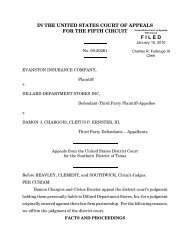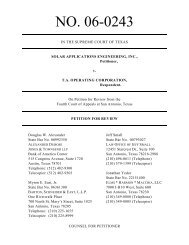Laughlin v. Nouveau Body & Tan - The Appellate Record
Laughlin v. Nouveau Body & Tan - The Appellate Record
Laughlin v. Nouveau Body & Tan - The Appellate Record
Create successful ePaper yourself
Turn your PDF publications into a flip-book with our unique Google optimized e-Paper software.
Case: 09-10622 Document: 00511064454 Page: 10 Date Filed: 03/29/2010No. 09-10622of federal law.” Id. at 58 (internal quotation marks omitted). Instead, the Courtagreed with the Eighth Circuit’s interpretation that, at his mother’s death, Drye“had . . . a valuable, transferable, legally protected right to the property at issue”and held that “in determining whether a federal taxpayer’s state-law rightsconstitute ‘property’ or ‘rights to property,’ ‘the important consideration is thebreadth of the control the taxpayer could exercise over the property.’” Id. at 61(alterations omitted) (quoting Morgan v. Comm’r, 309 U.S. 78, 83 (1940)).Applying this consideration, the Court concluded that because “Drye had theunqualified right to receive the entire value of his mother’s estate . . . , or tochannel that value to his daughter[, that control] rendered the inheritance‘property’ or ‘rights to property’ [under the IRC]” and affirmed the EighthCircuit’s judgment. Id. at 60.iii. Costas<strong>Nouveau</strong> argues that Drye applies here, effectively overruling Simpson,and that because <strong>Laughlin</strong> similarly had the power to channel his interest in hisfather’s estate—either to himself or to a known successor—he thus transferredproperty for purposes of § 727(a)(2). We have not had occasion to consider theapplication of Drye as it relates to “property” or “interests in property” under thebankruptcy code; however, the Ninth Circuit has considered whether Drye7applies under the bankruptcy code. In Gaughan v. Dittlof Revocable Trust (In7To date, no other circuit court has considered whether Drye applies in the bankruptcycontext. Several lower federal courts have considered whether Drye applies, with mostdeclining to extend its reasoning. Compare Lowe v. Sanflippo (In re Schmidt), 362 B.R. 318,322–23 (Bankr. W.D. Tex. 2007) (questioning Simpson post-Drye) and In re Kloubec, 247 B.R.246, 256 (Bankr. N.D. Iowa 2000) (“Debtors assert that as Drye involves tax liens, it isdistinguishable from issues raised in the bankruptcy context. However, it is the conclusionof this Court that, even though Drye was a tax lien case, the issue decided was identical to theissue presented here, that is, whether the state doctrine of relationship-back can modify rightscreated under Federal statutes.”), aff’d on other grounds 268 B.R. 173 (N.D. Iowa 2001) withGarrett v. Bank of Okla. (In re Faulk), 281 B.R. 15, 20 (Bankr. W.D. Okla. 2002) (“Even thoughDrye involved the construction of a tax lien statute, the trustee urges this court to apply theDrye holding to the instant case. He asserts that the definition of “transfer” under [§] 541 of10




